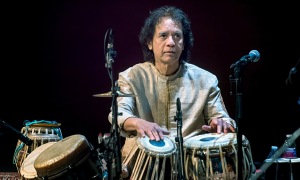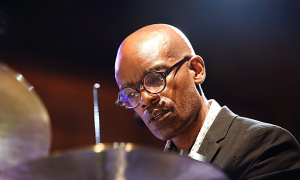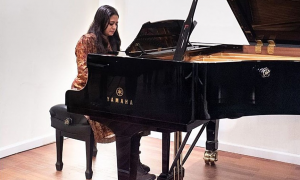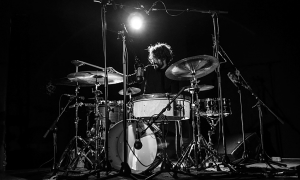Home » Jazz Articles » Under the Radar » A Different Drummer, Pt. 7: Rudy Royston’s Higher Calling
A Different Drummer, Pt. 7: Rudy Royston’s Higher Calling

Courtesy Jose Luis Luna
I grew up playing in church, so gospel music is my roots. I came to jazz because of the freedom of expression jazz allowed me. I was free to play whatever I wanted to play, but that didn’t mean I should…
—Rudy Royston
The Texas native grew up in Colorado in a large, musical family with eclectic tastes and spent half of the week playing in his local church. In high school, Royston received a scholarship to attend the Telluride Jazz Camp, solidifying his commitment to a future in music. He studied classical, jazz and marching percussion going on to play in statewide high school ensembles. Later he earned undergraduate degrees in music and English from the University of Denver, a teaching certificate from Metropolitan State University of Denver and a master's degree in music from Rutgers University. Following college, he played and recorded in the gospel, alternative rock and jazz genres. Royston went on to teach music in public school for a decade. He began playing drums and percussion as a youngster and later studied viola and saxophone. Royston has said that in maturing as a musician, he has shifted his focus from playing the instrument to playing the music.
Though he is a progressive theorist in terms of creative music, Royston has a strong academic interest in the history that surrounded the birth of jazz. A student of the Harlem Renaissance and the poetry of Langston Hughes, his research brings him back to the English classics as well. Royston is a social activist, multi-media creator, and an accomplished photographer. His photographs can be seen in the YouTube video of the title track from the PaNOptic album. It's an outlet that allows him to express many alternative perspectives within the context of his music.
Rudy Royston
All About Jazz: Could you tell me about where you grew up and what were your earliest musical Influences?Rudy Royston: I was born In Ft. Worth, Texas, and grew up In Denver, Colorado I'm the youngest of five with three older brothers and my oldest sister. My brothers were my earliest musical influences. They were very open to all kinds of music and very eclectic in their tastes. Since I was the youngest, I had no say on what music was on the moment's playlist [and] in a week's time might hear any genre of music from classical to country to jazz to funk to heavy metal to pygmy chants to yacht rock.
AAJ: What was the first Instrument you studied, and when were you Introduced to drumming?
RR: My first Instruments were percussion Instruments: bells, bongos, shakers. From my first memories, I was surrounded by percussion instruments. My father was manager of the shipping department of an instrument making company that made percussion for elementary schools across the nation. He would bring home the slightly defective ones, but he also had some amazing African bongos and finger harps. As far as drumming goes, I grew up in the Holiness church. When l was around five years old there was a drummer in the church who used to sit me in his lap and hold sticks in my hands while he played a song or two for the offering. I think that was the genesis of my love of drums and drumming.
AAJ: What Is It about drumming that appeals to you?
RR: Well you know that kind of changes from time to time. But I think mainly it is something I learned in church about the way drums can sculpt the entire shape of a tune and the atmosphere of a room. For me, drums are like a piano. There is melody, harmony, rhythm, words, there are textures and tones and colors and extremes, grooves, stylings. Drums themselves are all of the music to me.
AAJ: You're primarily known for your work in the jazz genre but you have much broader experience including church music and alternative rock. How did you come to focus on jazz?
RR: Again, I grew up playing in church, so gospel music is my roots. I played for a while with a Christian alternative rock band named Shaded Red and some with Christian artist Darrell Evans and some others. I came to jazz because of the freedom of expression jazz allowed me. I was free to play whatever I wanted to play, but that didn't mean I should. It was the freedom to express but also to create music purely from my own musical input that brought about that validation of autonomy jazz offers. I'm creating music through improvisation and freedom of expression.
AAJ: You spent a decade teaching music in public school. What were the main lessons that you wanted your students to take away from your class?
RR: The main lesson I wanted them to internalize was to enjoy music and being a musician, but my close second was that they were among the few people, artists, on the planet who held the power of an art form that unified all of humanity in their hearts and [that] responsibility was larger than all of us.
AAJ: How would you describe your development as an artist?
RR: I believe I have gone from what to why, from me to us. Early on I was most concerned about what I was playing, now I am most concerned with why I am playing what I play. I've gone from concern about how I sound to concern about how the music sounds. But I am still on that journey I can sometimes get a bit selfish when I play, I get excited and my love for drumming takes over and those times are the times when my drumming is most flashy and least powerful.
AAJ: Besides leading your own groups, you've recorded or played with an eclectic group of musicians including Aruán Ortiz, Tim Ries, Ben Allison, Bill Frisell, Ron Miles, Hank Roberts, Jon Irabagon, Dave Douglas, Linda May Han Oh and Rudresh Mahanthappa. These artists encompass many stylistic nuances. Do you take away something you can use as a drummer, with each of those experiences?
RR: I learn something new compositionally, stylistically, something about bandleading, soloing... every time I play with different artists each of them informs my schema about executing, expressing and composing music.
AAJ: Who are your current influences, musical or otherwise?
RR: I have been checking out a lot of street photographers lately, trying to see and "hear" the music in the photos. But I'm not sure there are any musical influences right now—on purpose. I just composed some music for my FBB band and I have actually been focused on trying to not have any influences and see what will happen if I just composed from a place that is totally me but maybe that is because I haven't been playing with others much for a while.
AAJ: What are some of the tools and instruments you're using? Do you use any uncommon percussion effects along with a standard drum kit?
RR: I am just using standard drum equipment at the time.
AAJ: When you compose, on what instrument do you develop your ideas?
RR: I usually compose on a tiny, two-octave keyboard I carry in my cymbal bag. I'll get the main idea of the tune on that keyboard, then later I will begin to expand on that idea on a piano or singing into my phone.
AAJ: Over your years of playing, how has your practice routine changed?
RR: I used to practice a bit more of a routine and rudiment regimen. Now I tend to practice different ways of playing what I want to relate. From past years I have developed pretty good hands,. Now it is just finding different ways to approach and express the drum kit itself. So, instead of emphasis on rudiments, which I still practice first, for about a half-hour, it's more emphasis on spontaneous creation in the moment.
AAJ: What type of techniques do you practice to advance your drumming skills?
RR: The time I take to practice rudiments I spend on the rudiments that I could never quite get right even after all these years. Also, I never really had lessons, so I am taking some time to experience some of the books on technique that I should know. And, I think it's time for a double pedal.
AAJ: How has the pandemic affected you? Is It more challenging to keep your skills sharp when you're playing in isolation?
RR: It's been very challenging. I am motivated most when I am in a position to create and make music with others. The sheer volume of sideman work keeps me necessarily focused and in pursuit of something. I know me, so I get no inspiration from what I will play. I already know what that will be. I get a lot of inspiration to play and compose from playing with others. During the pandemic, I have been digging deep into myself to find that inspiration during practice. I'm constantly trying to challenge myself to play something that is not my idea to play. But, for a while it was very hard to play. I felt a heaviness for all the suffering that seemed more important to me than my practice time. I had to remember the main lesson I was trying to teach my past band students: It is my pleasure and gift to offer art and beauty to the world at all times. It's what I can do to help. I had to remember to play for—and to—the times around me, not subject to them.
AAJ: Percussion solo albums are rare. How would you describe the challenges of those projects?
RR: I only recorded one, PaNOptic. The main challenge for me was relating the message of the music, the idea, the theme, the melody, and the harmony with only drums and cymbals. The idea is to play music, not drums, to not make a drum recording, but a music recording played on drums.
AAJ: The musicality of drummers/percussionists can often be overlooked. Bill Bruford said, "I've always seen the percussion or drum part for the song as being a standalone little work of art that, should all the other Instruments be silenced and the percussion soloed alone, would still sound unique and interesting." How do you experience the drummer/percussionist as not being limited to a rhythmic role In a group?
RR: This is what I meant in the last question. I have never played drums. That has never been my interest. I don't know how to do It. I can only play the whole of the music and idea I am pursuing. When I am playing with a band, I am playing the music of the band, not the drums of the band. That's why I need a chart with the melody. If I ever play like a drummer it is because the music is saying to play that way.
AAJ: What components do you need in the kit to be able to play melodically?
RR: Just a kit. There is melody inherent in the drums and cymbals and there is melody inherent in intentional, genuine thought. If your ideas are coming from a true place, they will be heard and/or felt. Of course, if other sounds are available, if you wish to add as much as possible, do it. It doesn't give you more melody, just more ways to express melody.
AAJ: All art has some historical context, even if unintended. Max Roach was the first drummer/composer to make a definitive, full-length political statement with "We InsIst!" You were personally influenced by Roach. What are your thoughts about the function of music in raising awareness of political or social issues?
RR: What more global and ubiquitous way is there to raise awareness about social issues? Music lives in every crevice of every age group, gender, race, class, religion. Music is very present and immediate. Political and social issues are issues of the heart. It Is natural and unavoidable that music will and should address every aspect of our lives.
Music Is the thing that penetrates and speaks [to] our hearts and reminds us how more alike we are than not. It is one of the true vehicles for understanding one another, if you want to raise not only awareness but the prospect of empathy to political or social issues.
AAJ: What has been the most significant event in your career to date?
RR: Moving to New York in 2006, after growing up In Denver and teaching public schools for 10 years.
AAJ: What Is the best advice you've received about playing?
RR: "If you keep accepting $60 gigs, that's all you will ever make!" Leslie Drayton, founding member of Earth, Wind and Fire; musical director and conductor for Marvin Gaye, etc.
AAJ: Is there a bucket list project related to drums/percussion or composition that you plan to undertake in the future?
RR: Compose a piece for orchestra and percussion.
Selected Discography
 Rudy Royston
Rudy RoystonPaNOptic
Greenleaf Music
2020
Like many jazz musicians in 2020, drummer/composer Rudy Royston has felt the direct effects of living in the coronavirus world. He found his streams of income drying up without gigs, but then experienced a fortunate twist of fate that stood him up. Head above water, the artist pays it forward by helping other musicians. The tracks that appear on PaNOptic were previously recorded but not released. Partnering with the MusiCares COVID-19 Relief Fund, all proceeds go to that fund.
Solo drum projects remain a relative rarity but there had been a spate of recent releases: the Gerry Hemingway project Reality Axis (SyncSource), Tim Daisy's Configurations (Relay), Oblio (Neither/Nor Records) from Italian percussionist Carlo Costa, Chad Taylor's Myths and Morals (eyes&ears Records)—all in 2018—and (h)rouf (Self-Produced, 2019), a percussion-choreography score by Swiss drummer Vincent Glanzmann. On each album, the artists experiment with some combination of extended technique, electronics and additional percussion instruments. Royston's PaNOptic takes on the more challenging setting of the unembellished acoustic drum kit.
The album is divided into three sections. The first six tracks were inspired by diverse artists from The Beatles to the Swing Era composer/violinist Victor Young, and the second grouping are tributes extended to Elvin Jones, Frisell, Jack DeJohnette and Roach. The last two sections are influenced by sacred music and a selection of poems and music from the likes of Langston Hughes and Herbie Hancock. Royston illustrates his broad interests across these twenty-three compact tracks. His composition, "defeRRed," incorporates a spoken verse from Langston Hughes' poem "What Happens to A Dream Deferred?" The gently progressing rumble of "desirE," theatrically explodes in time, and Royston captures the essence of Jones' playing on his original "intO ElVin." "Jack, fIgHt oR FligHT" and "s'TRopHy" are robust and authoritative pieces. PaNOptic reveals Royston's extraordinary ability to evocatively transpose jazz idioms to the solo drum kit.
BlaCk—Bad CoMPAny—BiRd; bLUes; ciTy buS StOp; defeRRed; desirE; foolish; intO ElVin; BilL; Jack, fIgHt oR FligHT; maXX; oWhNet; s'TRopHy; coMe; I'm Coming Home; MOTHER KELLY and the preacher part 1; mother kelly and THE PREACHER part 2-sermon; mr zoot suite—bruh Arnold; oNe SnaP fIngER; PaNOptic; pANt 1; pANt 2; pop LOVE soNg (prinS-esh); We Real Cool.
Rudy Royston: drums, cymbals, voice.
 Rudy Royston Trio
Rudy Royston TrioRise Of Orion
Greenleaf Music
2016
The visceral style of drummer Rudy Royston was considerably toned down on his leader debut 303 (Greenleaf, 2014), a septet outing where the drummer often worked within the context of an ensemble player. Pared down to a trio formation for Rise Of Orion, Royston retains the services of the ubiquitous saxophonist Jon Irabagon and bassist Yasushi Nakamura from his original group. Without a chordal instrument, and in this more intimate setting, Royston is free to unleash his more forceful side.
Eleven of the 13 pieces on Rise Of Orion were penned by Royston but it's easy to imagine that Royston had Irabagon's knotty, aggressive approach in mind on a number of these compositions. Both saxophonist and drummer demonstrate a deft handling of freewheeling complexity on the title track before the multi-layered "Nautical" allows Royston a revealing extended solo. Seventeenth-century composer Henry Purcell's "Dido's Lament" gets a searing, bluesy treatment showcasing Nakamura's expressive playing in the midst of reflective performances from Royston and Irabagon.
Rise Of Orion is an excellent vehicle to showcase Royston's diverse set of skills. From the slower-paced cover of Bill Withers' "Make a Smile for Me" to the frenetic closer "Belt," the drummer exhibits his ability to exercise sophistication as a center, no matter the speed or complexity of the improvisations. A challenging release, this is nevertheless the album to best hear the virtuosity of a drummer that has been publicly under-recognized in his career as a side man.
Rise Of Orion; Nautical; Alnitak; Sister Mother Clara; Man O To; Alnilam; Make A Smile For Me; Kolbe War; River Styx; Dido's Lament; Mintaka; We Had It All; Belt.
Rudy Royston: Drums; Jon Irabagon: saxophones; Yasushi Nakamura: bass.
< Previous
Black Lives - From Generation to Gene...
Next >
Welcome To Adventure
Comments
Tags
Under the Radar
Karl Ackermann
Rudy Royston}'s resume tells you that the drummer should be more recognized. Royston has racked up credits with {{Nate Wooley
Jon Irabagon
Tom Harrell
Aruan Ortiz
Rudresh Mahanthappa
Bill Frisell
JD Allen
Dr. Lonnie Smith
Ron Miles
Noah Preminger
Ben Allison
Tim Ries
Alex Sipiagin
Linda May Han Oh
Bruce Barth
Don Byron
Jenny Scheinmenn
Dave Douglas
Hank Roberts
Marvin Gaye
Gerry Hemingway
Tim Daisy
Carlo Costa
Chad Taylor
The Beatles
Elvin Jones
Jack DeJohnette
Herbie Hancock
Yasushi Nakamura
Concerts
May
15
Wed
Jun
5
Wed
Jun
5
Wed
For the Love of Jazz
 All About Jazz has been a pillar of jazz since 1995, championing it as an art form and, more importantly, supporting the musicians who create it. Our enduring commitment has made "AAJ" one of the most culturally important websites of its kind, read by hundreds of thousands of fans, musicians and industry figures every month.
All About Jazz has been a pillar of jazz since 1995, championing it as an art form and, more importantly, supporting the musicians who create it. Our enduring commitment has made "AAJ" one of the most culturally important websites of its kind, read by hundreds of thousands of fans, musicians and industry figures every month.
























